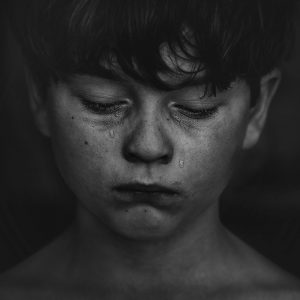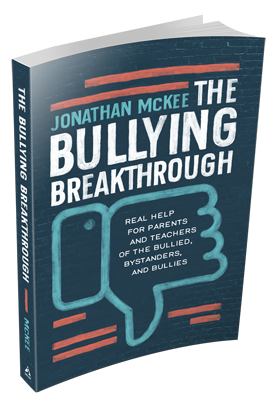
By Jonathan McKee
The following is an excerpt of one of the earlier chapters of my brand new book, The Bullying Breakthrough, releasing this month… the first book where I finally tell my story.
“Ignore them and they’ll ignore you.”
This is obviously the advice of someone who has never experienced daily torment from their peers.
It’s nearly impossible to ignore the entire class when they’re all laughing at you.
I was thirteen years old when I first considered taking my own life. I never told my parents or my teachers about these feelings. I never shared the extent of what kids were saying and doing to me because it was embarrassing. In fact, it was actually a little unbelievable.
In eighth grade a kid I’ll call Dennis actually started the Kill Jon Club. Absurd as it sounds, they actually made T-shirts with a gun sight drawn over a caricature of my face and the initials KJC. Four kids wore the shirts to school. The rest of the class laughed hysterically.
The teachers didn’t have a clue.
Let that sink in for a moment. The teachers didn’t have a clue.
How can a teacher miss an entire class laughing at one kid, knocking his books off his desk, smacking his neck when they walk by, and actually wearing T-shirts with a picture of a gun scope on his face?
I finally did tell an adult about everything that happened. When I told her, “They made T-shirts,” I’ll never forget her response.
“No, they didn’t.”
She actually told me it didn’t happen. She thought I was making it up.
Was this some freak occurrence?
Let’s fast-forward thirty years to the present.
No One Did Anything
An overweight boy called “lard-a**” daily.
A girl who was physically assaulted because she liked the wrong guy.
A crowd of kids taunting a kid with a prominent red birthmark on his face: “Hey, Kool-Aid!”
An overweight girl named Carla heartlessly labeled Cowla, simply trying to navigate around campus without being mooed at day after day.
These are just a few of the voices I heard as I began interviewing young people about the way they were treated at school. Hundreds of young people surveyed. . .and the one common denominator I kept hearing over and over again:
“No one did anything.”
I don’t want to be an alarmist, and I definitely don’t want to insinuate that parents, teachers, and principals don’t care. I’ve interviewed countless caring adults. I’ve met with counselors who recognize the problem and are striving to come alongside hurting kids. I’ve attended assemblies, even all-day programs proactively addressing the issue and providing caring adults to follow up.
But somehow kids are being missed. Many—dare I say most—of these kids’ voices are being drowned out in the crowd. Too many adults simply don’t have a clue what’s going on.
Literally every story I’ve heard contains the same element:
- “I told the adult on yard duty, and they said to just ignore it.”
- “I told my parents and they dismissed it.”
- “I told the principal, and he called the boys in and warned them. Nothing changed.”
I don’t have any problem believing these stories, because I’ve experienced all of this firsthand.
So let me ask this: In a world full of caring adults, how is it that we keep missing the cries of hurting kids?
The communication channels in many of today’s school systems need a total revamp. A youth worker I know told me a story of her daughter being bullied in eighth grade so severely that she ended up seeing a counselor and suffering depression.
No one likes me. I’m not good enough.
The mom didn’t find out until the end of the year when an incident occurred where parents were finally contacted.
“This is the first I’ve heard of it,” she told the principal.
The principal just backpedaled.
The same mom ran into some teachers at the school over the summer and they offered their condolences. “Wow, the situation was really bad. I don’t know how she made it through the year.”
No one had reported a thing the entire year.
Why is it that a teacher would assume someone else was handling it?
Why is it so many of us just become “bystanders” who don’t want to get involved?
How can we miss crowds of kids at recess hurling insults at an autistic kid? How is it that in a high school locker room kids are constantly ridiculed, tormented, slapped on the back of the legs, even hung up by their underwear? How can an entire campus know that there is going to be a fight after school—and adults actually warned about it—and yet a kid gets chased by a mob and beaten to the ground until needing to be hospitalized, while campus security toss a football back and forth? These are all very true stories.
As I embarked on this research, I was pretty confident I had a grasp on the issue, having worked with teenagers for the last twenty-five years. But honestly, I was surprised how I kept hearing the same story over and over again. . .the story of a young person crying out for help and an adult saying, “Just ignore it.” It was the one phrase that seemed to appear in almost every interview. A kid cried out for help, and his or her voice was dismissed by an adult.
The adult responses came in many different forms. Let me share one specific example involving Lindsey, the daughter of a friend of mine. The story began like many: Lindsey liked a boy, but another girl also liked the boy, so this girl began humiliating Lindsey out of jealousy and spite. She and her friends ganged up on Lindsey, making subtle comments as they passed her in the hallways, reaching through the crowd and knocking her books out of her hands, even pulling her hair. At junior prom, Lindsey wore a dress that tied in the back. In the crowd a hand reached out and untied the back of her dress, causing it to fall down in the front.
One day Lindsey was knocked to the ground and threatened, so much so that she feared for her safety. She fled to the bathroom, hid in a stall, and texted her mom: “Mom, please come get me. I’m scared.”
Her mom rushed to school and told the front office what happened. “My daughter was just threatened by a group of girls and is now hiding in the bathroom terrified. She just texted me from a stall.”
Wanna guess what the lady at the front office responded?
“She’s not supposed to be texting at school.”
As I share stories like this with my friends in the school systems, they are horrified. “That would never happen at our school.”
Are you sure?
Are you absolutely positive that the person supervising the playground is truly keeping watch, or is there a chance they’re just hanging out with a select tribe of kids? Are you sure you’re aware of what’s truly going on with your kids at school or in the most popular place today’s mean kids ridicule others: social media?
I missed many of the signs with my son, and I had experienced bullying myself at his age.
Why are we missing these cues?
As I reflect on those painful years when kids humiliated me every day, I realize I never said a word. I just became more removed and isolated. No one would eat lunch with me. After all, it would have been social suicide.
The one saving grace was at 2:43 the bell rang and I got to go home where I was loved and encouraged. It was safe. . . for about fifteen hours. Then I had to go back to school and live it all over again.
Today when the bell rings, kids might leave their school campus, but they can never escape the other world, a world where mockers and intimidators thrive. Ironically, they carry a gateway to that world right in their pockets with them, because they see that world as an avenue of escape—but in reality it’s putting them in bondage.
Kids across the globe are searching for friendship with someone who understands them. Often their search leads them to social media, the gaming world, anywhere they can connect with someone. . .from a distance.
But it’s not working. Social media isn’t filling the void. In fact, it’s making things worse. The voices of the bullied are still unheard…
 Author Josh McDowell calls The Bullying Breakthrough” Jonathan’s most vulnerable and insightful book yet! An eye-opening peek into the world of bullying today and what we can actually do to prevent it.”
Author Josh McDowell calls The Bullying Breakthrough” Jonathan’s most vulnerable and insightful book yet! An eye-opening peek into the world of bullying today and what we can actually do to prevent it.”
Social researcher Shaunti Feldhahn claims this is “Jonathan’s most important book so far,” describing it as “an essential guide to preventing and stopping bullying behaviors.”
The Bullying Breakthrough is available for PRE-ORDER on Amazon right now and will be releasing this month! Order your copy now!
Jonathan McKee
Jonathan McKee is the author of over twenty books including the brand new The Guy's Guide to FOUR BATTLES Every Young Man Must Face; The Teen’s Guide to Social Media & Mobile Devices; If I Had a Parenting Do Over; and the Amazon Best Seller - The Guy's Guide to God, Girls and the Phone in Your Pocket. He speaks to parents and leaders worldwide, all while providing free resources for parents on his website TheSource4Parents.com. Jonathan, his wife Lori, and their three kids live in California.



